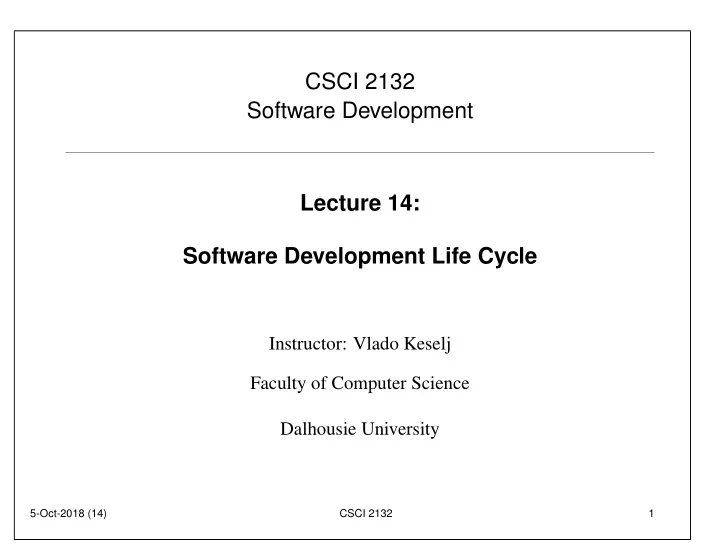

CSCI 2132 Software Development Lecture 14: Software Development Life Cycle Instructor: Vlado Keselj Faculty of Computer Science Dalhousie University 5-Oct-2018 (14) CSCI 2132 1
Previous Lecture • (Fire Alarm) • Integer and floating-point representation • Character types 5-Oct-2018 (14) CSCI 2132 2
Reading Characters • scanf can be used to read a character, but it does not ignore white space • For example, the following statements are not equivalent. (Find an input example.) scanf("%c", &ch); scanf(" %c", &ch); • getchar and putchar are used for input and output at the character level; e.g.: int ch = getchar(); putchar(ch); • int is used as return to detect EOF 5-Oct-2018 (14) CSCI 2132 3
Code Example #include <stdio.h> int main() { int ch; while (EOF != (ch = getchar()) && ch != ’\n’) { if (’a’ <= ch && ch <= ’z’) ch = ch - ’a’ + ’A’; putchar(ch); } putchar(’\n’); return 0; } 5-Oct-2018 (14) CSCI 2132 4
Code Example • Consider: EOF != (ch = getchar()) && ch != ’\n’ • Are brackets necessary? 5-Oct-2018 (14) CSCI 2132 5
Type Conversions • Consider the following code: float f = 3.4; • Works in C (not in Java) due to implicit type conversion • Implicit type conversion takes place in: – operands, and – assignments 5-Oct-2018 (14) CSCI 2132 6
Example with Operands • Example float f; double d; int i; d = d + f; f = f + i; • f is promoted to double, and i is promoted to double • operands are promoted to ‘narrowest’ type which will accomodate both 5-Oct-2018 (14) CSCI 2132 7
Implicit Conversion in Assignment • Example: int i = 8.92; • The right side is converted to the type of the left side 5-Oct-2018 (14) CSCI 2132 8
Type Casting • Type Casting, or explicit type conversion • Syntax: (type) expression • Example float f, frac_part; frac_part = f - (int)f; • What is calculated in frac_part ? 5-Oct-2018 (14) CSCI 2132 9
Another Example float quotient; int dividend = 5; int divisor = 4; quotient = dividend / divisor; quotient = (float) dividend / divisor; quotient = (float) (dividend / divisor); quotient = 1.0f * dividend / divisor; • What values are assigned in these four statements to quotient ? 5-Oct-2018 (14) CSCI 2132 10
Type Definitions Using typedef • We can define types using: typedef typename alternative_name • One example: typedef int Bool; Bool flag; • Particularly useful with more complex types, as we will see later 5-Oct-2018 (14) CSCI 2132 11
The sizeof Operator • Size of many C types are implementation-defined • sizeof operator = number of bytes required to store a type • Syntax: sizeof( type ) • Example: sizeof(char) • sizeof can also be applied to variables; e.g.: int i; printf("%d\n", sizeof(i)); 5-Oct-2018 (14) CSCI 2132 12
Software Development Life Cycle (SDLC) • SDLC is a general term that describes structure imposed on the development of a software product • Purpose – To reduce the risk of missing the deadline – To ensure product quality – To prevent “scope creep”, etc. • Many models have been proposed to describe SDLC 5-Oct-2018 (14) CSCI 2132 13
The Waterfall Model • A sequential design process Requirements Analysis (Software) Design Implementation (Coding) Verification (Testing) Maintenance (Patches...) 5-Oct-2018 (14) CSCI 2132 14
Waterfall: Advantages and Disadvantages • Advantages – Natural and easy to understand – Widely used – Reinforces notion of “design before coding” – Clear milestones • Disadvantages – Often not practical – Clients may change requirements – Designers may not be aware of implementation difficulties 5-Oct-2018 (14) CSCI 2132 15
The Rapid Prototyping Model 1. Gathering preliminary requirements 2. Fast prototyping 3. User evaluation of the prototype 4. Repeat the above steps if necessary 5. Discard the prototype and develop the software using a formal process 5-Oct-2018 (14) CSCI 2132 16
Rapid Prototyping: Advantages and Disadvantages • Advantages – Ensure that software product meets client’s requirements – Reduce time and cost if client requests changes during the process • Disadvantages – Adequate and appropriate user involvement may not always be possible – Cost of prototype development 5-Oct-2018 (14) CSCI 2132 17
More about Models • There are many other models • To be studied in the Software Engineering course • Choose an appropriate model depending on the particular software to be developed 5-Oct-2018 (14) CSCI 2132 18
Recommend
More recommend